by
Michael Hetherington
(click on photos to enlarge image)
ITALIAN ENAMELLED COMPACT-CASES BY OTTAVIO SPINELLI
The silversmith Ottavio Spinelli should be a well-known name
- at least for collectors of Italian silver enamelled compacts
(and, for that matter, brass enameled compacts) - but like all
of the Florentine silversmiths and jewelers who practiced their
art in the middle decades of the Twentieth Century they are all
but invisible to those who, today, prize and collect the objects
they once made.
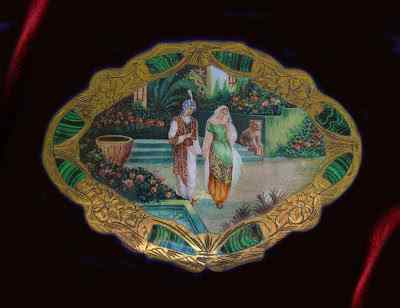 |
A wonderful example of the work of Ottavio
Spinelli
originally from the collection of Susan Holte
|
In earlier writings on other silversmiths such as Gino
Bicchielli, Renzo Cassetti and Giuliano Spinelli (undoubtedly a
relative of Ottavio's), I have attempted to identify particular
characteristics of the case types used by each artisan as well
as the decorative techniques they employed. Because after a
number of years looking at these cases it was apparent that
there were differences - many that are subtle, I admit - that
could help in identifying which particular silversmith produced
each case.
Now, this exercise in spotting the differences is made
irrelevant if the unique silversmith's mark is legible or if
there is some other mark that can reliably identify the
silversmith in question. In the case of Ottavio Spinelli this is
happily the case because there is another mark he used that is
unlike any other and, indeed, he seems to have been the only
Florentine silversmith who used the standard manufacturer's mark
together with his other unique mark. This mark is the stamp of a
bird.
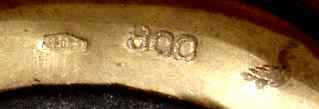
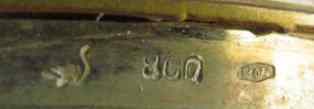
|
(left) A clear set of marks that identify
Ottavio Spinelli's work. The manufacturer's number
220 FI and the bird
(right) In this example the manufacturer's
mark is upside down - a not uncommon phenomenon that
can sometimes result in misidentification of a
case's origin.
|
Ottavio Spinelli's unique manufacturer's number is 220 FI
and it is usually found together with the bird mark, as well as
the assay mark 800 . In passing, I have to admit to not being
able to identify what type of bird was meant to be represented.
It seems to be a cross between a duck and a swan, but
determining this is less important than the fact that the mark
unquestionably identifies the case as coming from the Ottavio
Spinelli workshop.
In general terms, cases made by Ottavio Spinelli can be
identified by his preference for wide cases with a number of
lobes with a bifurcated (split) opening lift tab. In addition,
the metal border on the face of his cases is typically chased in
a zig-zag design.
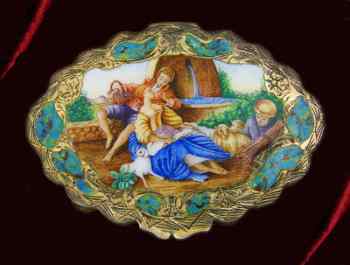
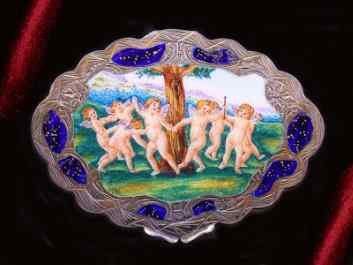
|
(left) A favourite case shape used by
Ottavio Spinelli. It comprises fifteen lobes,
including the hinge but excluding the split lift
tab. Note the zig-zag chasing on the border. The
scene is a miniature rendition of Francois Boucher's
work titled Autumn Pastoral.
(right) The same case shape with faux lapis
lazuli enamelled sections and illustrating Albi's
with titled Dance of the Cupids.
|
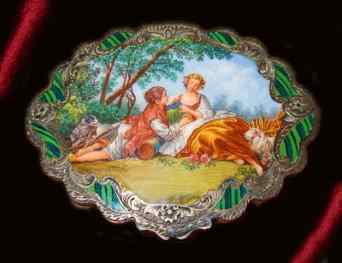

|
(left) The same case shape used to
illustrate Francois Boucher's work titled La
Musette. But in this example the border chasing is
done in the more conventional style of parallel
lines.
(right) But zig -zag border chasing is more
common in Ottavio Spinelli cases as is illustrated
in this example showing Reni's work titled Aurora.
|
A large, fifteen-lobed, case, four inches, or 10 centimetres,
wide was a favourite case shape used by Ottavio Spinelli, but he
also used similarly wide cases with slightly different shapes
and fewer lobes.
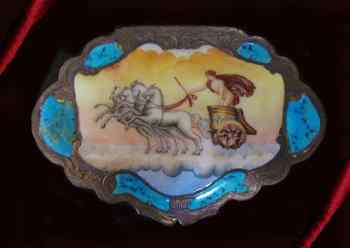
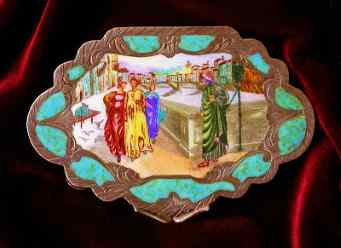
|
(left) This ten-lobed case with flat
hinged section has a wonderful illustration of
Raphael's Apollo.
(right) But this example, illustrating
Holiday's work titled Dante and Beatrice, uses
conventional border chasing in the same ten-lobed
case shape.
|
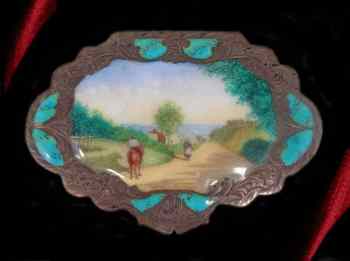
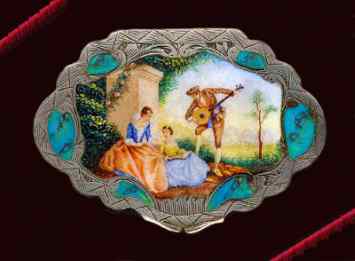
|
(left) As does this evocative image of
Corot's work titled The Road to Sevres.
(right) However, the more typical zig-zag
chasing appears in this case that illustrates
Lancret's iconic work titled The Music Lesson.
|
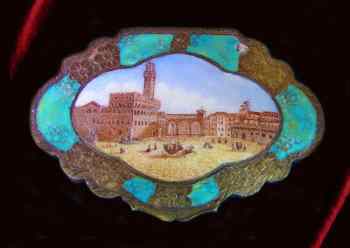
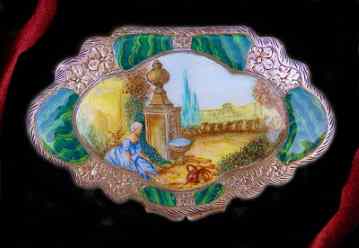
|
(left) This very rare scene from a work
titled View of Piazza della Signoria shows the
subtle variety employed by Ottavio Spinelli's
artisans in decorating their cases.
(right) And in this example the miniaturist
elected to use only one figure in Francois Boucher's
work titled Delights of Life in The Country.
|
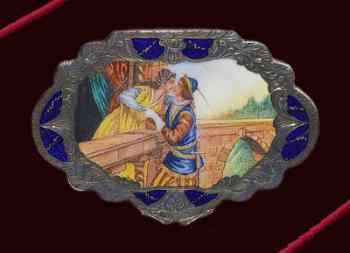
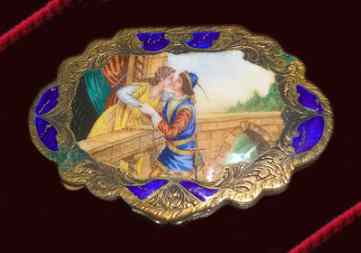
|
(left) This classic Romeo and Juliet
scene was another Ottavio Spinelli favourite
(right) ...and is one of the rare examples of
what might be described as a limited "production run"
of a particular scene. Each completed case is unique,
though.
|
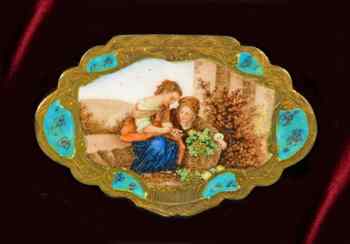
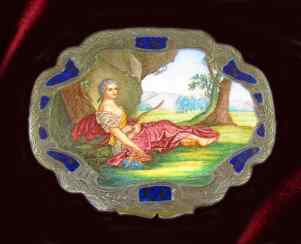
|
(left) Ottavio Spinelli used a huge
number of different scenes. Most were based on
original art works but some were made up. This one
was based on Murillo's work titled The Little Fruit
Seller.
(right) This scene is based on Nattier's work
titled Marie Adelaide of France as Diana.
|
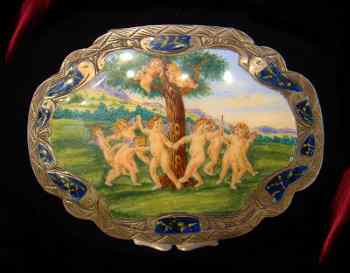
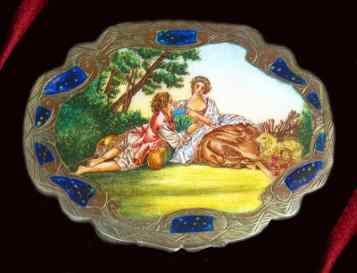
|
(left and right) Another favourite case
shape was more oval-looking with only four distinct
lobes.
|
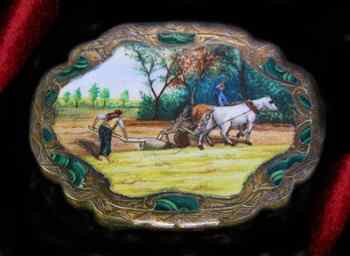
|
Ottavio Spinelli often selected scenes that
portrayed rural life. These were probably sold as
souvenirs to tourists visiting Italy.
|
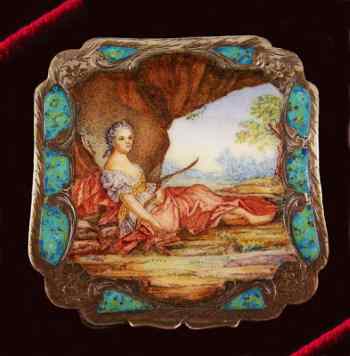
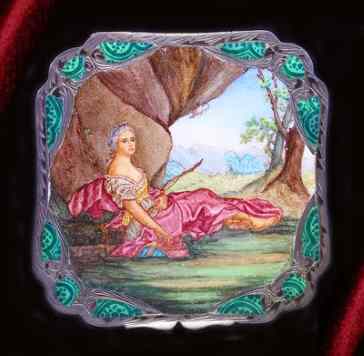
|
Not all Ottavio Spinelli's case shapes were oval
and he did use at least two square-ish cases.
|
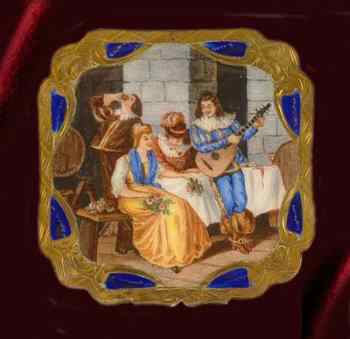
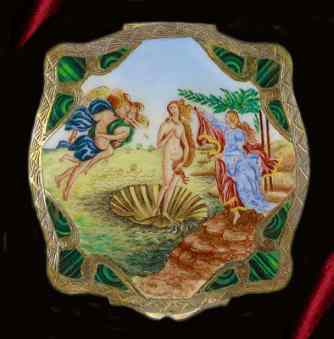
|
(left) This is a very rare scene, in the
Dutch Mannerist tradition, the original of which has
not yet been identified.
(right) This illustrates the iconic
Botticelli work titled The Birth of Venus.
|
Aside from the case shapes (and there is evidence of other
case shapes that will be revealed in a later post), another
common characteristic of Ottavio Spinelli cases is the chasing
on the reverse of the cases. While each design was unique (and
probably allowed the chaser to exercise his or her own artistic
temperament), there was a common feature associated with the
border, once again. There were two options for a chased border
and each relied on how the border on the cover was chased. If
the cover had a zig-zag border then the border on the base was
clear. If the cover had a conventionally chased border then the
border on the base was zig-zagged, Confused? Trust me, this is
what happened and is also suggestive of two distinct production
phases during the time Ottavio Spinelli operated.
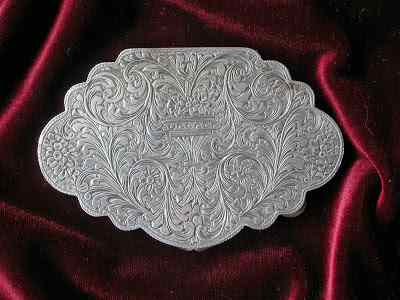 |
The reverse of the Dante and Beatrice ten-lobed
case
shown in this page. Note the small and continuous
zig-zag patter non the border that corresponds to
the
use of the conventional border chasing on the cover.
|
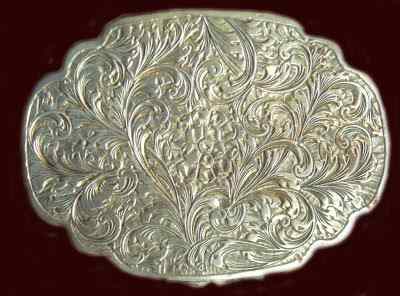 |
The reverse of the La Musette oval case with 4
lobes shown
in this page. Note the clear border that corresponds
to the zig-zag chasing on the border of the cover.
|
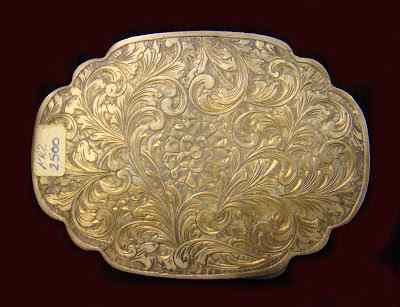 |
The reverse of the Dancing With Cupids oval case
with
4 lobes shown in this page. Note the clear border
that
corresponds to the zig-zag chasing on the border of
the cover.
|
A few, final, comments. I have not identified a single round
case that is marked with the bird stamp nor have I found a round
case with the maker's mark 220 FI. This is, to say the least,
unexpected and a little perplexing. Are we to conclude that
Ottavio Spinelli did not make round cases or, if he did, that
for some reason he did not mark them? If anyone has seen a round
case with the markings in question please let me know.
Regardless, Ottavio Spinelli, who made his cases entirely after
the end of The Second World War and possibly into the 1960s, was
a prolific case maker whose name must stand tall among
Florentine silversmiths of that period. In any event, his cases
can command very high prices and the first case illustrated in
this page recently (2013) sold for in excess of $1200.
Mike Hetherington
- 2015 -
About the Author:
Mike Hetherington is the owner of
http://collectingvintagecompacts.blogspot.com.au/ a
blog dedicated to the inquisitive vintage compact
collector who wants to know how, when and why compacts
and vanity cases came into being.
Mike is described as a lover of myths and fantasy, an
inveterate researcher seeking a reasonable version of
the truth as the search is just as much fun as the
findings.
|
|
|



























